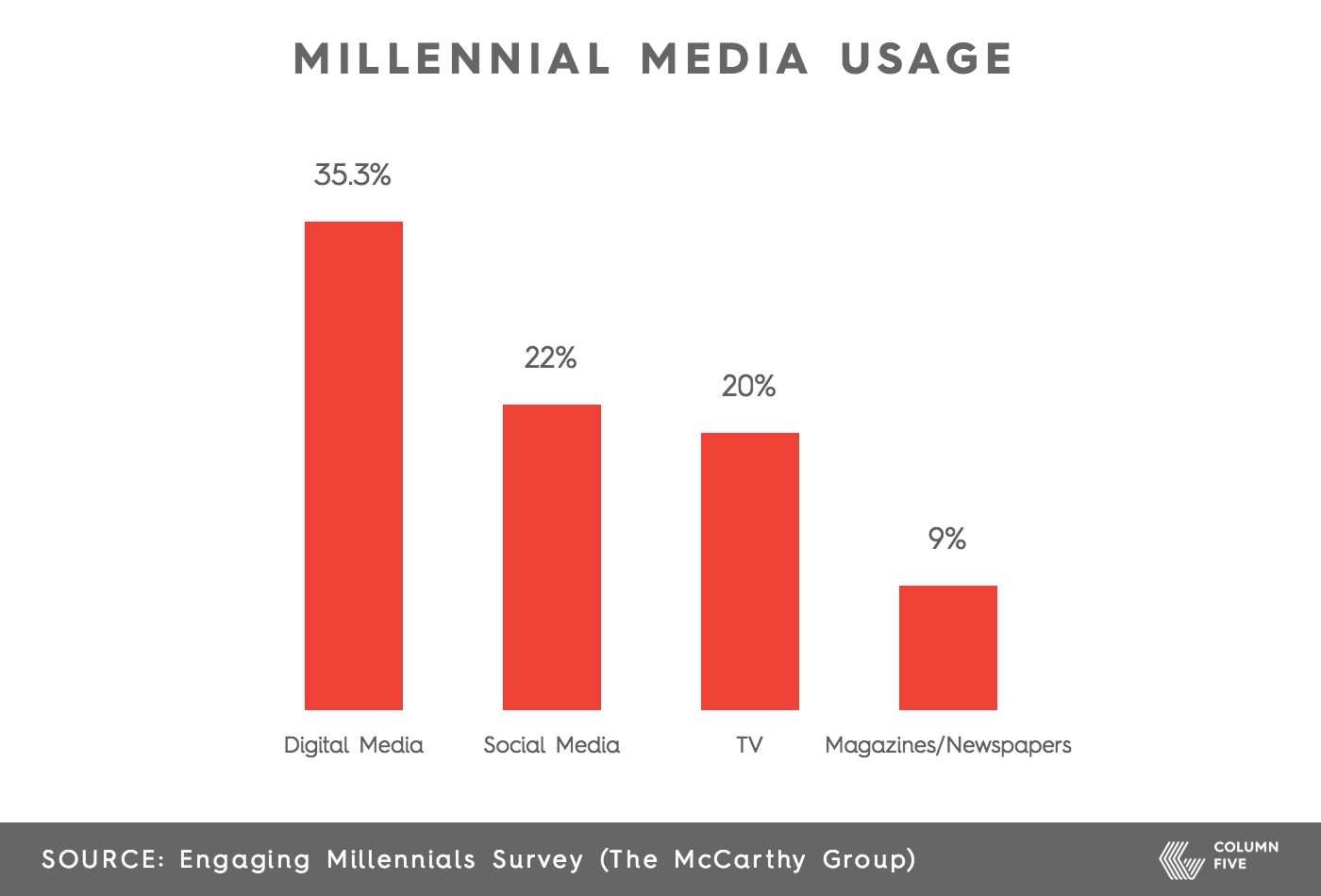Despite what you might have heard, advertising is not dead.
There are plenty of powerhouse brands whose success is greatly buoyed by that type of interruption marketing. But the Nikes and Coca-Colas of the world are basically prom kings and queens, always shining front and center. Meanwhile, the rest of us kids in the corner are struggling to get our own attention—without those huge ad spends.
For us, those old paradigms aren’t so effective. When you have a less-than-sexy product or a startup with little exposure, interruption marketing isn’t going to save the day. It’s engagement marketing that helps move the needle.

The Pitfalls of Interruption Marketing
The brand-consumer relationship has drastically changed since the heyday of Mad Men. Traditional interruption marketing, a relentless deluge of ads, sales, and promotional materials, was once the only option. It was a one-way conversation focused on persuasion.
Brands commanded attention by shouting at consumers, which was more effective at the time thanks to limited distribution channels, mainly TV, radio, and print.
Since that time, we’ve experienced a tectonic shift in technology, media, social perspectives, and consumer demographics.
Consumers now have more control over both the type of content they consume and how they consume it, which has thrown the brand-consumer power dynamic off. Millennials, now the majority of the workforce, are driving this shift.

The core problem lies in the way brands have traditionally communicated: throwing themselves in front of consumers, trying to persuade, or obnoxiously selling. This divisive dynamic doesn’t work.
Millennials want brands to respect their time and intelligence. They crave connection, exchange, and validation. They don’t want interruption. They want engagement.
The Era of Engagement Marketing
To reframe the brand-consumer relationship, you need to embrace engagement marketing. This strategy means interacting in ways that provide value to your audience, with the goal of forming genuine relationships based on mutual respect and trust.
Invite your customers to sit at the table, to become a part of your brand story.
Content is crucial in engagement marketing, as it is the primary mode of communication beyond one-on-one customer service interactions, especially through digital and social media (Millennials’ preferred channels).

It’s especially effective because it serves modern consumers’ core desires.
1) Consumers crave content.
There is more information available than ever, but audiences are picky about what they consume. They gravitate toward content that serves their needs, whether it’s information or a quick escape from reality. By providing this content, you are providing a valuable service to your audience.
According to a 2014 NewsCred survey, 64% of Millennials respond positively to useful content, 31% say they’re more likely to buy if it’s provided, and 30% refuse to read content that doesn’t entertain or educate.
2) Consumers choose to interact.
Millennials don’t want to be badgered or forced into a brand conversation. They want to willingly choose to engage with you.
When you have strong content and a powerful brand voice, you naturally attract consumers who are interested in what you have to say. The more engaging the content, the more likely they are to support your brand.
According to the NewsCred survey, 62% of Millennials say online content drives their brand loyalty.
3) Consumers demand transparency.
Because we are living in a socially-driven, hyperconnected world, audiences want to know exactly who they are connecting with.
There is no tolerance for faceless corporations with inauthentic messaging. Interestingly, in a 2013 Boston Consulting Group survey, Millennials cited the top two ways a brand can engage and interest them:
- Reward them with discounts
- Be authentic
If authenticity is as much of an influence as financial incentives, content that reflects your brand values is crucial.
4) Consumers want a purpose beyond profit.
Millennials are highly value-driven. They want to know exactly what the brands they buy believe in and support.
In a 2015 Millennial Branding survey, 75% said that it’s either fairly or very important that a company gives back to society instead of just making a profit.
This is especially important because consumers feel that the brands they align themselves with reflect their own identities. (In this sense, brands almost become a form of self-expression.)
Content provides a great opportunity to communicate your foundational thinking (vision, mission, and values) in a natural way. (Notably, the traditional ads that are impactful communicate more about what the brand stands for than what the product is, such as the Misty Copeland “I Will What I Want” spot for Under Armour.)
For these reasons, engagement marketing is the best tool to build a relationship with your audience—but only if you can execute content effectively.
5 Ways to Tackle Engagement Marketing
Just because you create content doesn’t mean you are nailing engagement marketing. Quality and consistency are the key to success.
Unfortunately, many brands are failing in their engagement marketing efforts, and even brands that have found initial success with content may not be reaching their full potential. This is often due to either a lack of knowledge or a weak supply chain.
To increase the efficacy of your engagement marketing efforts, here’s what to you need to do.
1) Invest in the infrastructure to handle the volume.
Engagement marketing requires a steady flow of content, which is what makes it different from traditional advertising. A one-off e-book won’t move the needle. You need a content team that can create a steady flow of quality content, distribute that content effectively, and track its success to optimize ongoing efforts.
This doesn’t necessarily mean you have to hire a huge team. But you do need to ensure your team members can fill the roles needed to help you succeed in the following areas:
- Content strategy
- Production (writers, editors, designers, developers, etc)
- Distribution
- SEO
To learn more about these roles, find out how to build the right content marketing team.
2) Cultivate a culture of content.
While content is driven by the marketing team, that doesn’t mean that they’re the only source of ideas. Your entire organization holds a wealth of knowledge, which can be translated to content.
Consider opening up your creative brainstorms to people who aren’t usually involved. You’ll be surprised at how much brainpower you really have at hand.
We’ve done this successfully by inviting members of our sales and finance teams into content meetings, which results in great ideas and much-needed perspective.
If you need an initial starting off point, start by talking to your team about what’s been on their mind lately. We’ve created lots of content inspired by these discussions, especially pertaining to:
- Areas of interest: For a Column Five Hack Day, a ragtag group of office gaming fanatics, which included designers, video editors, and developers, collaborated to create our first C5 video game, Groove Glider.
- Specialized skills: Our papercraft donut tutorial was created by an art director with a penchant for papercraft.
- Company culture: One of our most popular posts to date was a recap of our holiday Christmas gift.
- Personal causes: To help empower young girls and women, an important cause to our team, we collaborated on the Popcorn Project with Girls Inc. and created the People for Periods interactive infographic to help destigmatize menstruation.
In addition to encouraging ideas, you should also help expand their capabilities. That may require additional hires (think animators, videographers, etc.) or investments in additional skill sets. And remember: An important part of cultivating a culture of content is hiring people who are naturally curious, empathetic, and creative.
For more tips for finding ideas and creating content, check out our guide to master content creation.
3) Experiment with tools and technology.
Technology has ushered in this era of engagement marketing, and it will remain the fuel. Explore and experiment with anything that can improve your results, including:
- Marketing platforms
- Analytics and CRM
- Publishing tools
- Distribution tools
- Content marketing tools
- Design tools and mediums (including videos, motion graphics, or interactives)
Anything that makes content creation easier and more accessible for your team will help you tremendously. You can start with these 100+ tools for content marketing.
4) Streamline your process.
Engagement marketing is a marathon. Your goal should be to increase quality and efficacy as you go. Of course, with so many moving parts, bottlenecks and inefficiencies will inevitably sabotage.
Be willing to experiment with your process and strategy. Mix up your brainstorms. Learn how to work better with different creative types. Try new distribution tactics. (You can use our content distribution checklist to craft a content distribution strategy in 6 steps.) Otherwise, complacency will hold you back.
Continue Your Education
Pay attention to brands and publishers that are successful in their engagement marketing, keep up on trends, and try to level-up your knowledge, even if you think you’re an expert. (See our recent interviews with CoSchedule, LinkedIn, and Business Insider to start.) The more you know, the more effective you’ll be.
If you need an experienced partner to help facilitate your content or engagement marketing strategy, find out the 12 things you should look for in a content marketing agency. (We’re always here to chat, too.) And for more tips, check out our best fixes for your content marketing problems.





